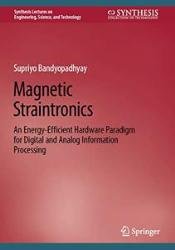 Название: Magnetic Straintronics: An Energy-Efficient Hardware Paradigm for Digital and Analog Information Processing
Название: Magnetic Straintronics: An Energy-Efficient Hardware Paradigm for Digital and Analog Information ProcessingАвтор: Supriyo Bandyopadhyay
Издательство: Springer
Год: 2022
Страниц: 139
Язык: английский
Формат: pdf (true), epub (true)
Размер: 38.5 MB
This book covers the new field of straintronics, using strain switched nanomagnets for extremely energy-efficient computing, information processing, communication, and signal generation. Based on well-established CMOS technology, traditional electronics have two significant shortcomings: excessive energy dissipation and volatility, which is the inability to retain information after power has been switched off. Straintronics is more energy-efficient and non-volatile (but also more error-prone), allowing it to eclipse traditional electronics in niche areas that are increasingly attracting attention, such as image processing and probabilistic computing, computer vision, Machine Learning, neuromorphic networks, probabilistic computing, and belief networks.
This monograph introduces the readers to some of the most important topical areas of magnetic straintronics that could lead to a potent hardware platform for processing digital and analog information at a minimal energy cost. Magnetic straintronics, hereafter referred to simply as “straintronics” for the sake of brevity, is the rapidly burgeoning field of science and engineering dealing with manipulating the magnetic states of magnetostrictive nanomagnets with electrically generated mechanical strain. These nanomagnets can implement a wide range of functional devices and circuits that are extremely energy-efficient and hence ideal for many applications, such as embedded processors, medically implanted devices, aggressively miniaturized stealth devices for defense and crime-fighting, and even mainframe computers.
The primitive unit of all digital hardware (computers, signal processors, communication devices, etc.) is a binary switch that has two “states” encoding the binary bits 0 and 1. Digital computing and signal processing are carried out by switching between the two states. The best switch is the one that can switch the fastest with minimal energy dissipation while boasting a low switching error rate for reliability. A straintronic switch, fashioned out of a magnetostrictive nanomagnet whose magnetization can assume only two stable orientations (representing bits 0 and 1), may be able to switch in less than 1 ns with energy dissipation as low as ~1 aJ when the magnetization is switched with electrically generated mechanical strain. The associated energy-delay product is one order of magnitude lower than what the best silicon field effect transistors today can offer. The low energy-delay product, of course, comes at a cost, and the cost is usually a high switching error rate. That high rate is a serious disadvantage for some applications, such as Boolean logic, but not so much for collective computational models (e.g. neuromorphic networks) where the collective activities of many devices working cooperatively elicit the computational or signal processing activity, and the failure of one or few devices to act properly does not impair the circuit operation. Straintronic devices have other attractive attributes as well, such as unusual characteristics that can be exploited to build better circuits, and, of course, non-volatility, which can be leveraged to implement superior architectures for specific digital and analog circuits. Non-volatility implies that the information in the switches (i.e. which of the two states it is in) is not lost once the device is powered off. Non-volatility can offer other advantages as well, such as resilience to hacking, energy saving (accruing from the fact that data do not have to be refreshed periodically), and no boot delay when powering up a computer.
Contents:
1. Magnetic Straintronics
2. Binary Switches for Digital Information Processing
3. Switching a Magnetic Switch with an Electrical Current or Voltage
4. Full Magnetic Reversal of a Magnetostrictive Nanomagnet Using Electrically Generated Strain
5. Non-volatile Memory Implemented with Straintronic Magnetic Tunnel Junctions
6. Straintronic Boolean Logic: Energy-Efficient but Error-Prone
7. Switching the Magnetizations of Magnetostrictive Nanomagnets with Time Varying Periodic Strain (Surface Acoustic Waves)
8. Analog Straintronics
9. Straintronic Nano-Antennas
10. Non-Boolean Straintronic Processors
11. Hybrid Straintronics and Magnonics
Скачать Magnetic Straintronics: An Energy-Efficient Hardware Paradigm for Digital and Analog Information Processing